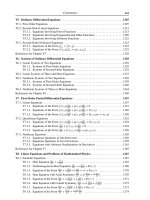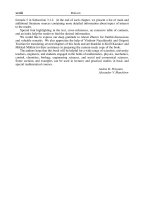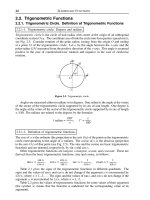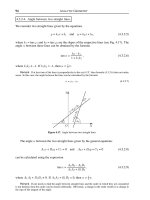Handbook of mathematics for engineers and scienteists part 9 pot
Bạn đang xem bản rút gọn của tài liệu. Xem và tải ngay bản đầy đủ của tài liệu tại đây (395.03 KB, 7 trang )
24 ELEMENTARY FUNCTIONS
2.2. Trigonometric Functions
2.2.1. Trigonometric Circle. Definition of Trigonometric Functions
2.2.1-1. Trigonometric circle. Degrees and radians.
Trigonometric circle is the circle of unit radius with center at the origin of an orthogonal
coordinate system Oxy. The coordinate axes divide the circle into four quarters (quadrants);
see Fig. 2.5. Consider rotation of the polar radius issuing from the origin O and ending
at a point M of the trigonometric circle. Let α be the angle between the x-axis and the
polar radius OM measured from the positive direction of the x-axis. This angle is assumed
positive in the case of counterclockwise rotation and negative in the case of clockwise
rotation.
O
M
1
1
x
α
y
1
1
Figure 2.5. Trigonometric circle.
Angles are measured either in radians or in degrees. One radian is the angle at the vertex
of the sector of the trigonometric circle supported by its arc of unit length. One degree is
the angle at the vertex of the sector of the trigonometric circle supported by its arc of length
π/180. The radians are related to the degrees by the formulas
1 radian =
180
◦
π
; 1
◦
=
π
180
.
2.2.1-2. Definition of trigonometric functions.
The sine of α is the ordinate (the projection to the axis Oy) of the point on the trigonometric
circle corresponding to the angle of α radians. The cosine of α is the abscissa (projection
to the axis Ox) of that point (see Fig. 2.5). The sine and the cosine are basic trigonometric
functions and are denoted, respectively, by sin α and cos α.
Other trigonometric functions are tangent, cotangent, secant,andcosecant.Theseare
derived from the basic trigonometric functions, sine and cosine, as follows:
tan α =
sin α
cos α
,cotα =
cos α
sin α
,secα =
1
cos α
,cosecα =
1
sin α
.
Table 2.1 gives the signs of the trigonometric functions in different quadrants. The
signs and the values of sin α and cos α do not change if the argument α is incremented by
2πn,wheren = 1, 2, The signs and the values of tan α and cot α do not change if the
argument α is incremented by πn,wheren = 1, 2,
Table 2.2 gives the values of trigonometric functions for some values of their argument
(the symbol ∞ means that the function is undefined for the corresponding value of its
argument).
2.2. TRIGONOMETRIC FUNCTIONS 25
TABLE 2.1
Signs of trigonometric functions in different quarters
Quarter
Angle in radians sin α cos α
tan α cot α
sec α cosec α
I
0 <α<
π
2
+ + + + + +
II
π
2
<α < π
+
– – – –
+
III
π <α <
3π
2
– –
+ +
– –
IV
3π
2
<α < 2π
–
+
– –
+
–
TABLE 2.2
Numerical values of trigonometric functions for some angles α (in radians)
Angle α
0
π
6
π
4
π
3
π
2
2π
3
3π
4
5π
6
π
sin α
0
1
2
√
2
2
√
3
2
1
√
3
2
√
2
2
1
2
0
cos α
1
√
3
2
√
2
2
1
2
0
–
1
2
–
√
2
2
–
√
3
2
–1
tan α
0
√
3
3
1
√
3
∞
–
√
3
–1 –
√
3
3
0
cot α
∞
√
3
1
√
3
3
0 –
√
3
3
–1
–
√
3
∞
2.2.2. Graphs of Trigonometric Functions
2.2.2-1. Sine: y =sinx.
This function is defined for all x and its range is y [–1, 1]. The sine is an odd, bounded,
periodic function (with period 2π). It crosses the axis Oy at the point y = 0 and crosses
the axis Ox at the points x = πn, n = 0,
1, 2, The sine is an increasing function
on every segment [–
π
2
+ 2πn,
π
2
+ 2πn] and is a decreasing function on every segment
[
π
2
+ 2πn,
3
2
π + 2πn]. For x =
π
2
+ 2πn, it attains its maximal value (y = 1), and for
x =–
π
2
+ 2πn it attains its minimal value (y =–1). The graph of the function y =sinx is
called the sinusoid or sine curve and is shown in Fig. 2.6.
O
1
π
π
x
y
π
2
1
yx= sin
π
2
Figure 2.6. The graph of the function y =sinx.
2.2.2-2. Cosine: y =cosx.
This function is defined for all x and its range is y [–1, 1]. The cosine is a bounded,
even, periodic function (with period 2π). It crosses the axis Oy at the point y = 1,and
26 ELEMENTARY FUNCTIONS
crosses the axis Ox at the points x =
π
2
+ πn. The cosine is an increasing function on every
segment [–π + 2πn, 2πn] and is a decreasing function on every segment [2πn, π + 2πn],
n = 0,
1, 2, For x = 2πn it attains its maximal value (y = 1), and for x = π + 2πn
it attains its minimal value (y =–1). The graph of the function y =cosx is a sinusoid
obtained by shifting the graph of the function y =sinx by
π
2
to the left along the axis Ox
(see Fig. 2.7).
O
1
π
x
y
π
1
yx= cos
π
2
π
2
Figure 2.7. The graph of the function y =cosx.
2.2.2-3. Tangent: y =tanx.
This function is defined for all x ≠
π
2
+ πn, n = 0, 1, 2, , and its range is the entire
y-axis. The tangent is an unbounded, odd, periodic function (with period π). It crosses the
axis Oy at the point y = 0 and crosses the axis Ox at the points x = πn.Thisisanincreasing
function on every interval (–
π
2
+ πn,
π
2
+ πn). This function has no points of extremum and
has vertical asymptotes at x =
π
2
+ πn, n = 0, 1, 2, The graph of the function y =tanx
isgiveninFig.2.8.
2.2.2-4. Cotangent: y =cotx.
This function is defined for all x ≠ πn, n = 0, 1, 2, , and its range is the entire y-axis.
The cotangent is an unbounded, odd, periodic function (with period π). It crosses the axis
Ox at the points x =
π
2
+πn, and does not cross the axis Oy. This is a decreasing function on
every interval (πn, π+πn). This function has no extremal points and has vertical asymptotes
at x = πn, n = 0,
1, 2, The graph of the function y =cotx isgiveninFig.2.9.
O
1
x
y
π
π
1
yx= tan
π
2
π
2
Figure 2.8. The graph of the function y =tanx.
O
1
x
y
π
π
1
yx= cot
π
2
π
2
3π
2
Figure 2.9. The graph of the function y =cotx.
2.2. TRIGONOMETRIC FUNCTIONS 27
2.2.3. Properties of Trigonometric Functions
2.2.3-1. Simplest relations.
sin
2
x +cos
2
x = 1,tanx cot x = 1,
sin(–x)=–sinx,cos(–x)=cosx,
tan x =
sin x
cos x
,cotx =
cos x
sin x
,
tan(–x)=–tanx,cot(–x)=–cotx,
1 +tan
2
x =
1
cos
2
x
, 1 +cot
2
x =
1
sin
2
x
.
2.2.3-2. Reduction formulas.
sin(x 2nπ)=sinx,
sin(x
nπ)=(–1)
n
sin x,
sin
x
2n + 1
2
π
= (–1)
n
cos x,
sin
x
π
4
=
√
2
2
(sin x cos x),
tan(x
nπ)=tanx,
tan
x
2n + 1
2
π
=–cotx,
tan
x
π
4
=
tan x
1
1 tan x
,
cos(x
2nπ)=cosx,
cos(x
nπ)=(–1)
n
cos x,
cos
x
2n + 1
2
π
= (–1)
n
sin x,
cos
x
π
4
=
√
2
2
(cos x sin x),
cot(x
nπ)=cotx,
cot
x
2n + 1
2
π
=–tanx,
cot
x
π
4
=
cot x
1
1 cot x
,
where n = 1, 2,
2.2.3-3. Relations between trigonometric functions of single argument.
sin x =
√
1 –cos
2
x =
tan x
√
1 +tan
2
x
=
1
√
1 +cot
2
x
,
cos x =
√
1 –sin
2
x =
1
√
1 +tan
2
x
=
cot x
√
1 +cot
2
x
,
tan x =
sin x
√
1 –sin
2
x
=
√
1 –cos
2
x
cos x
=
1
cot x
,
cot x =
√
1 –sin
2
x
sin x
=
cos x
√
1 –cos
2
x
=
1
tan x
.
The sign before the radical is determined by the quarter in which the argument takes its
values.
28 ELEMENTARY FUNCTIONS
2.2.3-4. Addition and subtraction of trigonometric functions.
sin x +siny = 2 sin
x + y
2
cos
x – y
2
,
sin x –siny = 2 sin
x – y
2
cos
x + y
2
,
cos x +cosy = 2 cos
x + y
2
cos
x – y
2
,
cos x –cosy =–2 sin
x + y
2
sin
x – y
2
,
sin
2
x –sin
2
y =cos
2
y –cos
2
x =sin(x + y)sin(x – y),
sin
2
x –cos
2
y =–cos(x + y)cos(x – y),
tan x
tan y =
sin(x y)
cos x cos y
,cotx cot y =
sin(y x)
sin x sin y
,
a cos x + b sin x = r sin(x + ϕ)=r cos(x – ψ).
Here, r =
√
a
2
+ b
2
,sinϕ = a/r,cosϕ = b/r,sinψ = b/r,andcosψ = a/r.
2.2.3-5. Products of trigonometric functions.
sin x sin y =
1
2
[cos(x – y)–cos(x + y)],
cos x cos y =
1
2
[cos(x – y)+cos(x + y)],
sin x cos y =
1
2
[sin(x – y)+sin(x + y)].
2.2.3-6. Powers of trigonometric functions.
cos
2
x =
1
2
cos 2x +
1
2
,
cos
3
x =
1
4
cos 3x +
3
4
cos x,
cos
4
x =
1
8
cos 4x +
1
2
cos 2x +
3
8
,
cos
5
x =
1
16
cos 5x +
5
16
cos 3x +
5
8
cos x,
sin
2
x =–
1
2
cos 2x +
1
2
,
sin
3
x =–
1
4
sin 3x +
3
4
sin x,
sin
4
x =
1
8
cos 4x –
1
2
cos 2x +
3
8
,
sin
5
x =
1
16
sin 5x –
5
16
sin 3x +
5
8
sin x,
cos
2n
x =
1
2
2n–1
n–1
k=0
C
k
2n
cos[2(n – k)x]+
1
2
2n
C
n
2n
,
cos
2n+1
x =
1
2
2n
n
k=0
C
k
2n+1
cos[(2n – 2k + 1)x],
sin
2n
x =
1
2
2n–1
n–1
k=0
(–1)
n–k
C
k
2n
cos[2(n – k)x]+
1
2
2n
C
n
2n
,
sin
2n+1
x =
1
2
2n
n
k=0
(–1)
n–k
C
k
2n+1
sin[(2n – 2k + 1)x].
Here, n = 1, 2, and C
k
m
=
m!
k!(m – k)!
are binomial coefficients (0!=1).
2.2. TRIGONOMETRIC FUNCTIONS 29
2.2.3-7. Addition formulas.
sin(x y)=sinx cos y cos x sin y,
tan(x
y)=
tan x tan y
1 tan x tan y
,
cos(x
y)=cosx cos y sin x sin y,
cot(x
y)=
1 tan x tan y
tan x tan y
.
2.2.3-8. Trigonometric functions of multiple arguments.
cos 2x = 2 cos
2
x – 1 = 1 – 2 sin
2
x,
cos 3x =–3 cos x + 4 cos
3
x,
cos 4x = 1 – 8 cos
2
x + 8 cos
4
x,
cos 5x = 5 cosx – 20 cos
3
x + 16 cos
5
x,
sin 2x = 2 sin x cosx,
sin 3x = 3 sin x – 4 sin
3
x,
sin 4x = 4 cos x (sin x – 2 sin
3
x),
sin 5x = 5 sin x – 20 sin
3
x + 16 sin
5
x,
cos(2nx)=1 +
n
k=1
(–1)
k
n
2
(n
2
– 1) [n
2
–(k – 1)
2
]
(2k)!
4
k
sin
2k
x,
cos[(2n+1)x]=cosx
1+
n
k=1
(–1)
k
[(2n+1)
2
–1][(2n+1)
2
–3
2
] [(2n+1)
2
–(2k–1)
2
]
(2k)!
sin
2k
x
,
sin(2nx)=2n cos x
sin x +
n
k=1
(–4)
k
(n
2
– 1)(n
2
– 2
2
) (n
2
– k
2
)
(2k – 1)!
sin
2k–1
x
,
sin[(2n+1)x]=(2n+1)
sin x+
n
k=1
(–1)
k
[(2n+1)
2
–1][(2n+1)
2
–3
2
] [(2n+1)
2
–(2k–1)
2
]
(2k+1)!
sin
2k+1
x
,
tan 2x =
2 tan x
1 –tan
2
x
,tan3x =
3 tan x –tan
3
x
1 – 3 tan
2
x
,tan4x =
4 tan x – 4 tan
3
x
1 – 6 tan
2
x +tan
4
x
,
where n = 1, 2,
2.2.3-9. Trigonometric functions of half argument.
sin
2
x
2
=
1 –cosx
2
,cos
2
x
2
=
1 +cosx
2
,
tan
x
2
=
sin x
1 +cosx
=
1 –cosx
sin x
,cot
x
2
=
sin x
1 –cosx
=
1 +cosx
sin x
,
sin x =
2 tan
x
2
1 +tan
2
x
2
,cosx =
1 –tan
2
x
2
1 +tan
2
x
2
,tanx =
2 tan
x
2
1 –tan
2
x
2
.
2.2.3-10. Differentiation formulas.
d sin x
dx
=cosx,
d cos x
dx
=–sinx,
d tan x
dx
=
1
cos
2
x
,
d cot x
dx
=–
1
sin
2
x
.
30 ELEMENTARY FUNCTIONS
2.2.3-11. Integration formulas.
sin xdx=–cosx + C,
cos xdx=sinx + C,
tan xdx=–ln| cos x| + C,
cot xdx =ln| sin x| + C,
where C is an arbitrary constant.
2.2.3-12. Expansion in power series.
cos x = 1 –
x
2
2!
+
x
4
4!
–
x
6
6!
+ ···+(–1)
n
x
2n
(2n)!
+ ··· (|x| < ∞),
sin x = x –
x
3
3!
+
x
5
5!
–
x
7
7!
+ ···+(–1)
n
x
2n+1
(2n + 1)!
+ ··· (|x| < ∞),
tan x = x +
x
3
3
+
2x
5
15
+
17x
7
315
+ ···+
2
2n
(2
2n
– 1)|B
2n
|
(2n)!
x
2n–1
+ ··· (|x| < π/2),
cot x =
1
x
–
x
3
+
x
3
45
+
2x
5
945
+ ···+
2
2n
|B
2n
|
(2n)!
x
2n–1
+ ···
(0 < |x| < π),
where B
n
are Bernoulli numbers (see Subsection 18.1.3).
2.2.3-13. Representation in the form of infinite products.
sin x = x
1 –
x
2
π
2
1 –
x
2
4π
2
1 –
x
2
9π
2
1 –
x
2
n
2
π
2
cos x =
1 –
4x
2
π
2
1 –
4x
2
9π
2
1 –
4x
2
25π
2
1 –
4x
2
(2n + 1)
2
π
2
2.2.3-14. Euler and de Moivre formulas. Relationship with hyperbolic functions.
e
y+ix
= e
y
(cos x + i sin x), (cos x + i sin x)
n
=cos(nx)+i sin(nx), i
2
=–1,
sin(ix)=i sinh x,cos(ix)=coshx,tan(ix)=i tanh x,cot(ix)=–i coth x.
2.3. Inverse Trigonometric Functions
2.3.1. Definitions. Graphs of Inverse Trigonometric Functions
2.3.1-1. Definitions of inverse trigonometric functions.
Inverse trigonometric functions (arc functions) are the functions that are inverse to the
trigonometric functions. Since the trigonometric functions sin x,cosx,tanx,cotx are
periodic, the corresponding inverse functions, denoted by Arcsin x, Arccos x,Arctanx,









